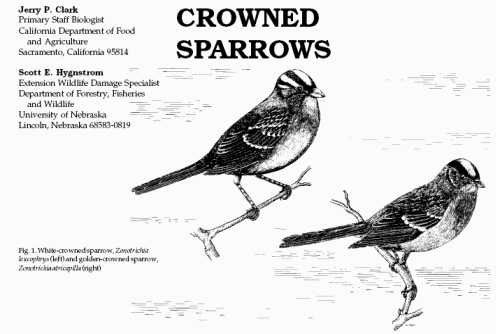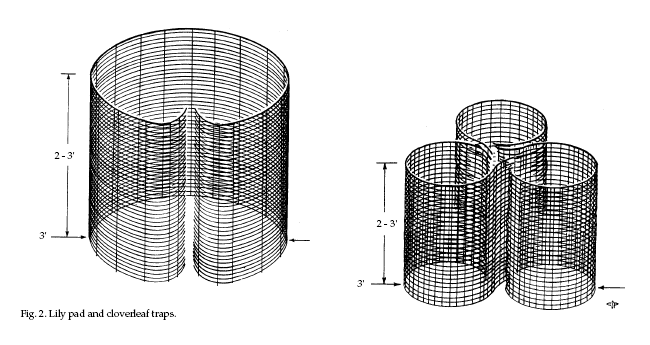|
|
|
|
 |
BIRDS: Sparrows, Crowned |
|
|

Identification
White-crowned sparrows (Zonotrichia
leucophrys, Fig. 1) are distinguished by their pink or
yellowish bill, erect posture, gray throat and breast,
and prominent crown streaked with black and white.
Geographic races, including the mountain (Z. l. oriantha),
Gambel’s (Z. l. gambelii), Nuttall’s (Z. L. nuttalli),
and Puget Sound white-crowned sparrow (Z. l. pugetensis)
show minor differences in head pattern, bill color, and
song. Their songs vary geographically, but consist
primarily of clear whistles. Golden-crowned sparrows (Zonotrichia
atricapilla, Fig. 1) are similar in appearance to
white-crowned sparrows with the exception that they have
no white head stripes. Instead, adults have a dull
golden-yellow central crown stripe that is heavily
bordered with black. Immatures look like female house
sparrows, but are larger, darker, have longer tails, and
usually have a yellowish crown. Their song consists of
three to five clear whistles that descend in scale. They
are less numerous and cause fewer problems than
white-crowned sparrows.
Range
White-crowned sparrows are
abundant in the western United States. They breed
primarily in Alaska and Canada and winter in the western
and southern United States and Mexico. Breeding and
wintering ranges overlap in California, Oregon,
Washington, and other western states. Gambel’s, the most
important, race, breeds in Alaska and western Canada but
winters in the interior valleys of California and from
San Francisco Bay southward.
Golden-crowned sparrows
breed along the coast from Alaska to northern Washington
and winter west of the Cascades and in the Sierra Nevada
to Baja California. They migrate south to California in
October and stay until April.
Habitat
White-crowned sparrows are
birds of the chaparral, brushy river bottoms, brush
piles, rubbish heaps, dense weed fields, and fence rows.
They commonly winter in dense hedges and thick plantings
of shrubbery found near towns and suburbs.
Golden-crowned sparrows commonly winter in boreal scrub
and spruce.
Food Habits
Food of white-crowned
sparrows averages 75% plant and 25% animal matter. Most
of the animal food is taken during the breeding season.
During the winter months whitecrowned sparrows feed
primarily on seeds. The diet of golden-crowned sparrows
is thought to be similar.
General Biology
Gambel’s white-crowned
sparrows appear in California valleys in September and
reach their maximum density during October, becoming
injurious to crops in localized areas. They remain
extremely abundant until March and gradually leave by
May.
Nests are built in bushes
or on the ground among mosses sheltered by higher
vegetation. White-crowned and golden-crowned sparrows
lay 3 to 5 eggs. One brood is raised per year.
Incubation takes 12 days, with age at first flight
commonly 10 days.
Damage and Damage Identification
The crowned sparrows are
involved in crop depredations over a wide area and upon
a great variety of crops. Newly sown lawn grass and
garden and flower seedlings are often completely
consumed. Waves of migrating crowned sparrows have been
known to destroy every small flower and vegetable
plantlet in home gardens. The damage is most severe in
areas adjacent to brushy river bottoms. Extensive damage
often occurs to commercial plantings of lettuce,
broccoli, sugar beets, alfalfa, and grain. Depredations
are most noticeable in field crops that are adjacent to
river bottom brush or weedy fields or have shrubbery or
trees planted for windbreaks. Damage occurs along the
margins of the fields near dense cover favored by these
birds and is usually limited to the outer 50 to 100 feet
(15 to 30 m) of the field. Seedlings are often consumed
by crowned sparrows when crop seeds germinate and emerge
from the soil. Damage normally stops when the seedlings
reach a height of 3 or 4 inches (7.6 to 10.2 cm).
Crowned sparrows play a
minor role in debudding almond and other deciduous fruit
trees. Occasionally, a few trees near a wood or brush
pile may be severely attacked. Depredations increase as
the buds swell.
Legal Status
Crowned sparrows are
classified as migratory nongame birds in the Code of
Federal Regulations. Depredation permits are required
from the US Fish and Wildlife Service before any control
activities can be initiated. Crowned sparrows may be
controlled in California under the general supervision
of the county agricultural commissioner.
Damage Prevention and Control Methods
Exclusion
To protect flower seedlings and home vegetable
gardens, grow plants under frames covered with wire or
plastic netting.
Habitat Modification
Since crowned sparrows usually feed within a few
yards of secure cover, the elimination of all useless
brush piles, rolls of wire, and stacks of wood around
vulnerable crops is desirable. Eliminate weedy borders
along fields. Destroy fence rows and unnecessary
shrubbery if occupied by sparrows.
Frightening
Historically, the most widely used sound devices for
minimizing crowned sparrow depredations have been the
automatic propane exploders. These units should be moved
every day or two to prevent the birds from becoming
habituated to the sound. Shell crackers fired from a
12-gauge shotgun, bird bombs, and whistlers discharged
from a 6-mm flare pistol are commonly used to frighten
sparrows from damaged fields. Some growers have reported
limited success with raptor-mimicking kites tethered to
stationary posts positioned along crop borders.
Avitrol® Mixed Grains
(0.5%) is a toxic chemical that produces flock-alarming
taken during the breeding season. During the winter
months whitecrowned sparrows feed primarily on seeds.
The diet of golden-crowned sparrows is thought to be
similar. E-99 reactions in birds that ingest a
sufficient quantity. It is currently registered in
California to control crowned sparrows that may damage
sprouting crops. Prebaiting is usually necessary with
untreated grain (fine chick scratch) to establish a
feeding pattern. The prebait should be placed in trays
in the same area where the treated bait will be exposed.
Avitrol®-treated chick scratch must be exposed in trays
only. Set trays out in the field after the crop is
planted and before crowned sparrows have moved into the
area. Each bait tray should contain one part Avitrol®
Mixed Grain concentrate with two to nine parts of
untreated fine chick scratch. The quantity of treated
bait to expose per tray will vary depending on the
amount taken by crowned sparrows during prebaiting.
Several trays should be placed where the birds are
normally observed. Bait should be replaced if it becomes
water soaked or depleted.
Repellents
Granular formulations of capsicum are federally
registered for repelling sparrows from certain fruit,
vegetable, and grain crops. Read the product label for
specific information.
Toxicants None are
registered.
Trapping
Crowned sparrows are usually quite easy to trap
using lily pad or cloverleaf traps and have been taken
by modified Australian crow traps. Use milo or finely
cracked corn as bait.

The lily pad trap and
cloverleaf trap are easy to set up and peg to the ground
(Fig. 2). They are effective in catching small numbers
of crowned sparrows. These traps are usually 3 feet (1
m) high and 3 feet (1 m) wide.
Australian crow traps are
used to capture crows, magpies, and ravens. The traps
can be modified by changing the entrance, and used to
capture crowned sparrows, starlings, blackbirds, house
finches, and house sparrows (Fig. 3). Minor
modifications can be made to fit the trap on a truck or
trailer. The basic design of the trap, however, should
not be changed.
Proper trap location is
one of the most important factors in achieving good
results. Observe the problem area to determine flyways
and resting, perching, and feeding areas before placing
traps. Place traps in open areas where they can be
easily seen. Traps have been most effective where birds
enter fields and orchards, or near resting and perching
sites.
Trapped crowned sparrows
serve as decoys to other birds. Decoy birds are usually
essential in attracting other crowned sparrows. Use one
to five live decoys, depending on the size of the trap.
Provide food and water at all times to keep decoys alive
and to make the trap more attractive to wild birds.
Canary grass seed, wild bird seed mix, or chick scratch
work well to maintain decoy birds. Install 1/4-inch
(0.6-cm) dowel rods to serve as perches, especially in
larger traps. Perches should run the full length of the
trap, about 1 foot (30 cm) from the sides and halfway
between the top and the bottom of the trap. Cold winds
or hot sun can stress trapped birds. Fasten burlap to
the sunny side of the trap to provide shade in the
summer.
With small traps, the
captured birds may be removed by hand. Birds can be
removed from modified Australian crow traps by hand or
with a small net. Several birds can be removed by
cutting a 6 x 6-inch (15 x 15-cm) exit hole that is
easily opened and closed in an upper corner of the rear
of the trap. Place a small holding cage on the outside
of the trap over the open exit hole and herd the birds
from the trap into the holding cage. To euthanize the
birds, place the holding cage in a plastic bag and
inject carbon dioxide through a hose until the birds are
dead. Burn or bury the dead birds.

Acknowledgments
Figures 1, 4, and 5 from
Clark (1986). Figures 2 and 3 were adapted from Robbins
et al. (1983) by David Thornhill, University of
Nebraska-Lincoln.
For Additional Information
Beal, F. E. L. 1910. Birds of California in relation to
the fruit industry. Biol. Survey Bull. No. 34. US Dep.
Agric.
Clark, J. P. 1986.
Depredating birds. Pages 701-1 - 726-1 in J. P. Clark,
ed. Vertebrate pest control handbook. Calif. Dep. Food
Agric. Sacramento.
Peterson, R. T. 1961. A
field guide to western birds. Houghton Mifflin Co.
Boston. 309 pp.
Robbins, C. S., B. Brunn,
and H. S. Zim. 1983. Birds of North America. Golden
Press. New York. 360 pp.
Editors
Scott E. Hygnstrom Robert
M. Timm Gary E. Larson
PREVENTION AND CONTROL OF
WILDLIFE DAMAGE — 1994
Cooperative Extension
Division Institute of Agriculture and Natural Resources
University of Nebraska -Lincoln
United States Department
of Agriculture Animal and Plant Health Inspection
Service Animal Damage Control
Great Plains Agricultural
Council Wildlife Committee
Special
thanks to:
Clemson University
|